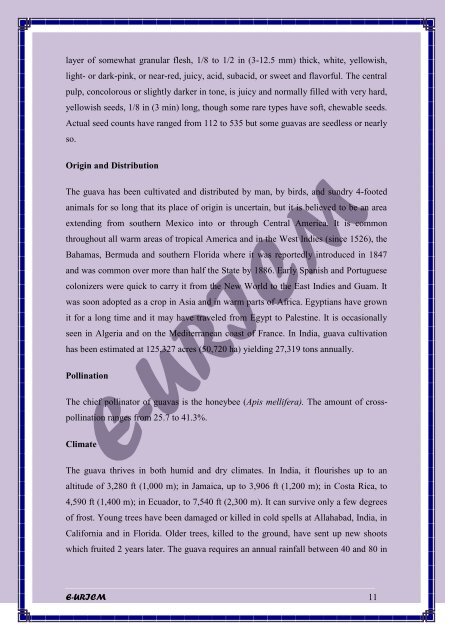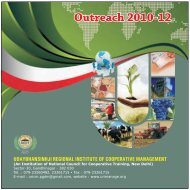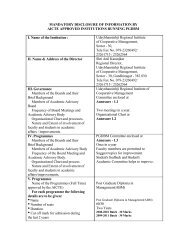URICM - UDAYBHANSINHJI - Regional Institute of Cooperative ...
URICM - UDAYBHANSINHJI - Regional Institute of Cooperative ...
URICM - UDAYBHANSINHJI - Regional Institute of Cooperative ...
Create successful ePaper yourself
Turn your PDF publications into a flip-book with our unique Google optimized e-Paper software.
layer <strong>of</strong> somewhat granular flesh, 1/8 to 1/2 in (3-12.5 mm) thick, white, yellowish,light- or dark-pink, or near-red, juicy, acid, subacid, or sweet and flavorful. The centralpulp, concolorous or slightly darker in tone, is juicy and normally filled with very hard,yellowish seeds, 1/8 in (3 min) long, though some rare types have s<strong>of</strong>t, chewable seeds.Actual seed counts have ranged from 112 to 535 but some guavas are seedless or nearlyso.Origin and DistributionThe guava has been cultivated and distributed by man, by birds, and sundry 4-footedanimals for so long that its place <strong>of</strong> origin is uncertain, but it is believed to be an areaextending from southern Mexico into or through Central America. It is commonthroughout all warm areas <strong>of</strong> tropical America and in the West Indies (since 1526), theBahamas, Bermuda and southern Florida where it was reportedly introduced in 1847and was common over more than half the State by 1886. Early Spanish and Portuguesecolonizers were quick to carry it from the New World to the East Indies and Guam. Itwas soon adopted as a crop in Asia and in warm parts <strong>of</strong> Africa. Egyptians have grownit for a long time and it may have traveled from Egypt to Palestine. It is occasionallyseen in Algeria and on the Mediterranean coast <strong>of</strong> France. In India, guava cultivationhas been estimated at 125,327 acres (50,720 ha) yielding 27,319 tons annually.PollinationThe chief pollinator <strong>of</strong> guavas is the honeybee (Apis mellifera). The amount <strong>of</strong> crosspollinationranges from 25.7 to 41.3%.ClimateThe guava thrives in both humid and dry climates. In India, it flourishes up to analtitude <strong>of</strong> 3,280 ft (1,000 m); in Jamaica, up to 3,906 ft (1,200 m); in Costa Rica, to4,590 ft (1,400 m); in Ecuador, to 7,540 ft (2,300 m). It can survive only a few degrees<strong>of</strong> frost. Young trees have been damaged or killed in cold spells at Allahabad, India, inCalifornia and in Florida. Older trees, killed to the ground, have sent up new shootswhich fruited 2 years later. The guava requires an annual rainfall between 40 and 80 inE-<strong>URICM</strong> 11





